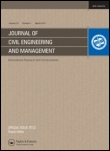
Journal of Civil Engineering and Management
Scope & Guideline
Building bridges between research and real-world application.
Introduction
Aims and Scopes
- Sustainable Construction Practices:
This area emphasizes the development and implementation of sustainable methods in construction, including energy-efficient building designs, waste management, and the use of environmentally friendly materials. - Technological Innovation in Civil Engineering:
The journal highlights research on new technologies such as Building Information Modeling (BIM), machine learning, and blockchain applications that enhance construction processes and project management. - Risk Management and Safety in Construction:
This focus area explores methodologies for assessing and managing risks in construction projects, including safety protocols, predictive analytics, and decision-making frameworks. - Infrastructure Development and Maintenance:
Research under this category deals with the design, construction, and maintenance of infrastructure systems, addressing challenges related to urban planning, transportation, and public utilities. - Public-Private Partnerships (PPP):
The journal discusses frameworks and case studies related to PPPs, exploring aspects such as investment strategies, risk sharing, and governance in large-scale projects. - Construction Project Management:
This area covers methodologies and tools for effective project management, including scheduling, resource allocation, and performance evaluation.
Trending and Emerging
- Integration of Digital Technologies:
There is a significant trend towards integrating digital technologies such as BIM, IoT, and AI in construction processes. This includes research on how these tools can improve efficiency, safety, and sustainability. - Collaborative Project Delivery Models:
Emerging studies focus on collaborative approaches to project delivery, such as Integrated Project Delivery (IPD) and Design-Build methods, which enhance teamwork and reduce conflicts. - Resilience and Adaptation Strategies:
Research is increasingly addressing how infrastructure can be designed to be resilient against climate change and natural disasters, focusing on adaptive strategies for existing and new structures. - Behavioral and Social Factors in Construction:
A growing body of work explores the impact of human behavior, stakeholder engagement, and organizational culture on project outcomes, emphasizing the importance of soft skills in construction management. - Data-Driven Decision Making:
The journal is seeing an increase in studies that leverage big data analytics for decision-making in construction projects, aiming to enhance forecasting, resource management, and overall project performance.
Declining or Waning
- Traditional Construction Methods:
Research focusing solely on conventional construction techniques has decreased, as the industry increasingly adopts modern technologies and innovative practices. - Single-Disciplinary Approaches:
There is a noticeable decline in studies that do not integrate interdisciplinary approaches. The trend is moving towards research that combines insights from various fields such as economics, sociology, and environmental science. - Static Risk Assessment Models:
The use of traditional, static models for risk assessment in construction has waned, with a growing preference for dynamic, data-driven approaches that utilize real-time data and machine learning techniques.
Similar Journals
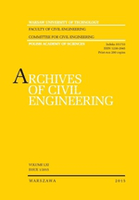
Archives of Civil Engineering
Championing Excellence in Structural InnovationArchives of Civil Engineering is a premier academic journal published by POLISH ACAD SCIENCES, dedicated to advancing the field of civil and structural engineering. Established in 1996, this open-access journal has been pivotal in disseminating high-quality research and innovation in engineering practices, particularly since adopting open access in 2010. With an ISSN of 1230-2945 and E-ISSN of 2300-3103, it enjoys a notable reputation, currently ranked in Q3 of the Civil and Structural Engineering category for 2023, reflecting its considerable contribution to scholarly content in the discipline. The journal caters to a diverse audience of researchers, professionals, and students, providing them with a platform to share and access essential findings. Its commitment to high academic standards is underscored by its ranking in Scopus, where it stands at Rank #265/379. Located in Warsaw, Poland, the journal aims to promote international collaboration and foster knowledge exchange in civil engineering, making it an indispensable resource for anyone involved in this dynamic field.

Advances in Civil Engineering
Innovating Infrastructure, Inspiring ChangeAdvances in Civil Engineering is a leading peer-reviewed journal published by HINDAWI LTD, dedicated to advancing knowledge and innovation in the field of civil and structural engineering. Holding an esteemed Q2 ranking in the 2023 category for Civil and Structural Engineering, this journal serves as a vital platform for disseminating cutting-edge research and practical applications that address contemporary challenges in infrastructure development, sustainable design, and material science. Launched in 2008 and operating as an Open Access journal since 2009, it promotes the free exchange of ideas by ensuring that all articles are accessible to researchers, professionals, and students globally. The journal is also indexed in Scopus, ranking at #142 out of 379 in its category, situating it within the 62nd percentile of its peers. With a focus on interdisciplinary collaboration and innovative solutions, Advances in Civil Engineering contributes significantly to the ongoing evolution of engineering practices and education, making it an essential resource for anyone involved in or studying the ever-evolving field of civil engineering.
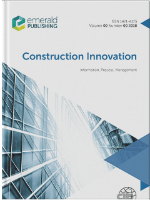
Construction Innovation-England
Shaping Tomorrow's Construction Landscape TodayConstruction Innovation, published by Emerald Group Publishing Ltd, is a prestigious journal dedicated to advancing knowledge in the fields of architecture, building and construction, civil and structural engineering, and computer science. With an impressive Q1 ranking across multiple categories, it holds a significant position in the academic landscape, alongside a strong Scopus ranking that further highlights its impact in engineering disciplines. The journal, bearing the ISSN 1471-4175 and E-ISSN 1477-0857, serves as a critical platform for researchers, practitioners, and students who seek to explore innovative practices and methodologies in construction. Readers can expect rigorous peer-reviewed articles that address contemporary challenges and spearhead innovations within the industry. Since its inception in 2001, Construction Innovation has established itself as a vital resource for the dissemination of knowledge, fostering collaboration and dialogue among professionals committed to shaping the future of construction and engineering practices.
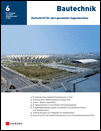
Bautechnik
Innovating the foundations of civil and structural engineering.Bautechnik is a premier academic journal in the fields of Building and Construction and Civil and Structural Engineering, published by ERNST & SOHN in Germany. With a history dating back to 1969 and a significant converged timeline through various years, this journal offers a rich repository of peer-reviewed research dedicated to advancing the principles, methodologies, and innovations within its domains. Bautechnik is currently ranked in the Q3 category for both building and construction, as well as civil and structural engineering, indicating its relevance and contribution to the academic community. Though it does not offer open access, its curated content is accessible to a global audience of researchers, professionals, and students striving for excellence in their fields. The journal aims to foster discussions and disseminate knowledge that impacts the future of construction, architecture, and engineering practices.

Revista Ingenieria de Construccion
Empowering Engineers with Open Access KnowledgeRevista Ingenieria de Construccion is a prominent open-access journal dedicated to advancing knowledge and practice in the fields of building and construction engineering, as well as civil and structural engineering. Published by the Pontificia Universidad Católica de Chile, specifically the Department of Engineering and Construction Management, this journal has been providing free access to quality research outputs since 1986, ensuring that vital information is available to both practitioners and academics globally. With its current placement in the Q4 category of both the Building and Construction and Civil and Structural Engineering quartiles, it serves as a platform for innovative studies and critical discussions, positioning itself strategically within the academic landscape. The journal is indexed in Scopus, ranking #157 in Building and Construction and #291 in Civil and Structural Engineering, reflecting the growing impact and relevance of its contributions. Researchers, professionals, and students are encouraged to engage with the rigorous and diverse content published within its pages, fostering a vibrant academic and practical discourse.
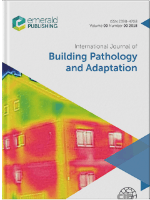
International Journal of Building Pathology and Adaptation
Unveiling new dimensions in building resilience.International Journal of Building Pathology and Adaptation is a premier publication dedicated to advancing knowledge in the field of building pathology and adaptation. Established by the esteemed Emerald Group Publishing Ltd, this journal serves as a vital platform for researchers and practitioners focusing on the assessment, preservation, and innovative adaptation of built environments. With an impressive Q2 ranking in both Building and Construction and Civil and Structural Engineering, and a Scopus ranking of #62 out of 223 in the relevant engineering disciplines, the journal showcases high-quality research with significant practical implications. Although currently not featuring an open-access model, its access options cater to a wide audience aiming to explore cutting-edge studies from 2017 to 2024. The journal's commitment to bridging the gap between academic inquiry and real-world application makes it an essential resource for anyone dedicated to advancing the resilience and sustainability of the built environment.

Revista de la Construccion
Exploring Cutting-Edge Solutions in Construction EngineeringRevista de la Construcción is a pivotal academic journal dedicated to the field of civil engineering and construction, published by the prestigious Pontificia Universidad Católica de Chile, Escuela de Construcción Civil. With its ISSN 0718-915X, this journal serves as a crucial platform for disseminating innovative research, case studies, and advancements in construction methodologies that address contemporary challenges within the industry. While currently not classified as open access, it provides valuable insights benefiting researchers, professionals, and students engaged in construction development and sustainability. The journal enhances the academic discourse and contributes significantly to knowledge in engineering practices, project management, and material science. Based in Santiago, Chile, the journal aims to foster collaboration and knowledge exchange among experts both locally and globally, making it an essential resource for those striving to advance the science and practice of construction.
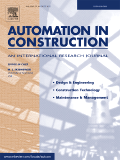
AUTOMATION IN CONSTRUCTION
Exploring the Intersection of Automation and Engineering ExcellenceAUTOMATION IN CONSTRUCTION is a premier academic journal published by Elsevier, dedicated to advancing the fields of Building and Construction, Civil and Structural Engineering, and Control and Systems Engineering. Since its inception in 1992, this journal has served as a vital platform for disseminating innovative research and practical applications in automation technologies within the construction industry. With a distinguished 2023 impact factor reflected in its Q1 ranking across multiple engineering categories—securing rank #3 in Civil and Structural Engineering and rank #3 in Building and Construction—AUTOMATION IN CONSTRUCTION stands out as a leading resource for researchers, professionals, and students keen on staying at the forefront of this rapidly evolving field. The journal offers access to cutting-edge studies that explore automation processes, methodologies, and tools, contributing to the enhancement of productivity and sustainability in construction practices. With contributions from global experts, each issue of AUTOMATION IN CONSTRUCTION provides comprehensive insights that help drive innovation and foster collaboration.

CANADIAN JOURNAL OF CIVIL ENGINEERING
Shaping Tomorrow's Infrastructure with Today’s DiscoveriesCanadian Journal of Civil Engineering, published by Canadian Science Publishing, serves as a premier platform for the dissemination of innovative research and development in the fields of civil and structural engineering, as well as environmental science. Established in 1971, this journal maintains a robust reputation, achieving a Q3 ranking in both civil engineering and general environmental science categories as of 2023. While it does not currently offer open access, the journal is accessible to a wide audience of researchers, professionals, and students who are keen to stay abreast of the latest advancements in civil engineering practices. With a significant number of yearly publications and a committed editorial board, the Canadian Journal of Civil Engineering contributes to the foundational knowledge and practical applications in the engineering community, thereby playing a critical role in addressing contemporary challenges in civil infrastructure and environmental sustainability.

Civil Engineering Journal-Stavebni Obzor
Connecting Ideas, Building TomorrowWelcome to the Civil Engineering Journal-Stavebni Obzor, an esteemed academic publication dedicated to advancing the field of civil engineering. Published by the Czech Technical University in Prague, Faculty of Civil Engineering, this journal has provided a platform for innovative research and critical discourse since its inception. With an ISSN of 1210-4027 and an E-ISSN of 1805-2576, this Open Access journal has been facilitating wide dissemination of knowledge in civil engineering since 2014, ensuring that valuable research reaches a global audience without barriers. The journal is committed to fostering collaboration among researchers, professionals, and students, encouraging the exchange of ideas that drive the discipline forward. Its diverse scope encompasses various aspects of civil engineering, making it an essential resource for anyone looking to stay at the forefront of this dynamic field. Located in Prague, a hub of engineering excellence, this journal not only reflects the latest trends and innovations but also contributes to shaping the future of civil engineering.